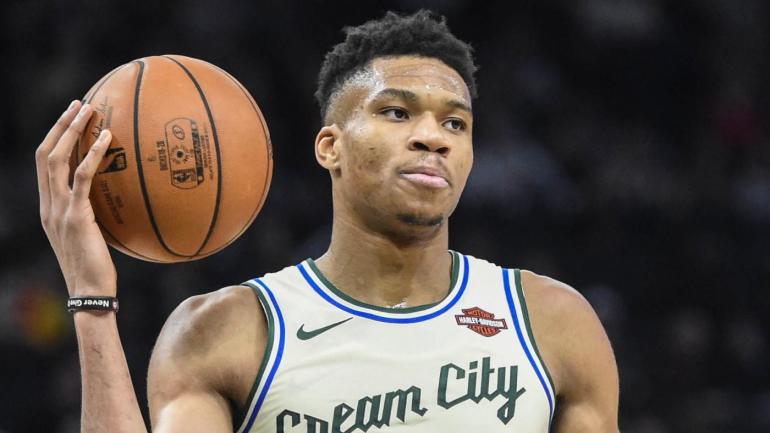
Giannis Antetokounmpo is going to be a very wealthy man. On Tuesday, the back-to-back MVP signed the biggest contract in NBA history, a five-year supermax arrangement that will keep him in Milwaukee through at least the 2024-25 season. The deal is worth more than $45 million per year, making him the highest-paid athlete in North American team sports in terms of average annual value, and every penny in the deal is guaranteed. Antetokounmpo is set for life.
Yet he could have been a good deal richer if not for the coronavirus pandemic. That's because of the unique rules governing max contracts in basketball. The max is not a dollar figure. It is a percentage of the salary cap. When a player signs a max extension like this one, the dollar figures are left blank until the cap is determined for the season in which the deal kicks in. The cap itself is typically determined by revenue, and the pandemic severely limited that revenue. As a compromise, the NBA and the NBPA settled on a pre-determined cap number for this season, $109,140,000, which was the number used last season as well. Moving forward, the cap will grow between three and 10 percent annually based on how much revenue the league generates.
That is where the $228.2 million figure you've likely seen comes from. A three percent increase on the $109,140,000 cap comes out to $112,414,200. As revenue is expected to be relatively low this season, that is the projected cap for next season, when the new Giannis deal kicks in. As his MVP awards make him eligible for designated veteran status, his new deal starts at 35 percent of that cap figure, and grows by eight percent annually. Add it all up and you get $228.2 million.
2021-22 | $39,344,970 |
2022-23 | $42,492,567 |
2023-24 | $45,640,164 |
2024-25 | $48.787,761 |
2025-26 | $51,935,358 |
Total | $228,200,820 |
Again, this number is set in stone. If fans are able to return to arenas sooner than expected, the league might be able to generate more revenue than it anticipates. In the absolute best-case scenario, the cap would rise 10 percent, up to $120,054,000. In that scenario, Giannis would net over $15 million more over the life of his contract.
2021-22 | $42,018,900 |
2022-23 | $45,380,412 |
2023-24 | $48,741,924 |
2024-25 | $52,103,436 |
2025-26 | $55,464,948 |
Total | $243,709,620 |
This scenario is viewed as highly unlikely, though. Teams are operating with that $112.4 million cap projection, which informs the $228.2 million value being associated with the Giannis contract. The odds overwhelmingly suggest that is what he is going to make. It just isn't what he would have made if the pandemic had been averted.
In September of 2019, The Athletic's Shams Charania reported that the NBA projected a $125 million salary cap for the 2021-22 season. Had that been the case, the raw numbers on Antetokounmpo's contract would have been absolutely staggering.
2021-22 | $43,750,000 |
2022-23 | $47,250,000 |
2023-24 | $50,750,000 |
2024-25 | $54,250,000 |
2025-26 | $57,750,000 |
Total | $253,750,000 |
To put this into perspective, remember that only two decades ago, Alex Rodriguez signed the biggest contract in the history of sports at $252 million over 10 years. This contract would not only exceed the total value of that one, but would have done so in half as many years. It would have paid Giannis over $50 million per year, and because an individual player's maximum salary is never lower than 105 percent of their previous salary, it would have set him up to earn over $60 million for the 2026-2027 season if he was productive enough to command that much. For a player to reach that salary organically, the cap would need to grow to over $171 million, a 57 percent jump over its current level.
Based on these numbers, we can project that the pandemic cost Giannis at least $25,549,180, the difference between that $253,750,000 figure and the $228,200,820 he's actually expected to receive. The "at least" qualifier is necessary there because there is another salary limiter that we need to acknowledge, even if we can't specifically quantify it: escrow.
Under normal circumstances, 10 percent of player salaries are held in an escrow account each season. This is done as a safeguard in case player salaries exceed 51 percent of the basketball-related income they are entitled to. If players make too much in a given season, owners can take some of it back, up to that 10 percent per player. Owners rarely need to use this option, and when they do, it's never the entire 10 percent.
But the league estimates that 40 percent of BRI comes from fans attending games at arenas. That revenue, for the time being, is gone, meaning ownership is almost certain to take back that escrow money. It isn't going to be limited to 10 percent either. Due to the unique circumstances surrounding this season, the players and owners have agreed to a number of alterations. First, in order to cover revenue losses, the escrow hit for any single season can be spread across multiple years (up to the next two afterward). Second, the maximum withholding for any single season is now 20 percent.
There is no guarantee that the league ever actually does withhold 20 percent of player salaries, but let's imagine a nightmare scenario in which so much revenue is lost this season that it becomes necessary for the two following campaigns. That would cost Giannis another $16,367,507, bringing his take-home amount down to around $212 million on this new deal.
Again, these numbers are not finalized, and again, Giannis is going to make a lot of money regardless. But the amount he is set to lose because of this pandemic is substantial. Players like Magic Johnson, Larry Bird and Kareem Abdul-Jabbar didn't earn $40 million across their entire careers. Now, Giannis is in line to potentially lose that much off of a single contract because of the coronavirus.


















